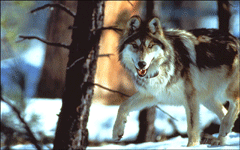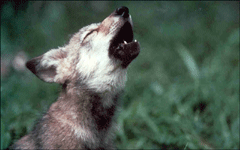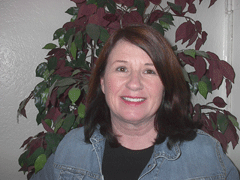Living with the Lobo
Air Date: Week of April 11, 2008

A Mexican Wolf in a pre-release pen (Courtesy of the U.S. Fish and Wildlife Service)
It’s been 13 years since we aired the award-winning story, The Wolf and the Soul of the West. Host Bruce Gellerman talks with rancher Jan Holder about techniques to keep wolves and cattle separate and how the ranching community has reacted to the re-introduction of wolves in Arizona.
Transcript
GELLERMAN: It’s Living on Earth, I’m Bruce Gellerman. And now an update to Sandy Tolan’s story about wolves. Jan and Will Holder, the ranchers in our story who were in favor of reintroducing the wolf into Arizona, were lone voices in the wilderness. Most of their neighbors were strongly opposed to the plan. Jan Holder joins us from a studio in Tucson, Arizona, the city she now calls home because the Holders no longer live on their remote ranch.
HOLDER: We had to take the vast majority of our cattle off because of the extended drought in Arizona.

A Mexican Wolf pup practices howling (Courtesy of the U.S. Fish and Wildlife Service)
HOLDER: Absolutely not.
GELLERMAN: The U.S. Fish and Wildlife Service was able to reintroduce wolves with great success in the Great Lakes area and in the Rocky Moutains. In fact, they were being taken off the endangered species list. But they haven’t done very well in the Southwest. I guess there were just, what, eleven introduced; there are only about 50 now. And they say they need at least 100 to make a sustainable population.
HOLDER: I believe that’s true. I know that they’ve had a lot of problems. We’ve made a lot of mistakes, I think, with the wolf reintroduction.
GELLERMAN: What do you mean?

Jan Holder has been a rancher in Bear Canyon, Arizona. She and her husband halted ranching due to a drought but hope to return as soon as they can. (Courtesy of Jan Holder)
GELLERMAN: Because I heard, there was, the Defenders of Wildlife had been reimbursing ranchers for cows that were attacked by wolves.
HOLDER: Absolutely. But Defenders of Wildlife is a private, non-profit organization, and it’s taken them a long time to get people to gain acceptance for the ideas that we’re talking about.
GELLERMAN: Jan, what were some of the techniques that they were using?
HOLDER: Well some of them are as low-tech as being around your cattle a lot. Defenders of Wildlife is now, I know, paying for herders. Most of the people that are out there ranching on public lands – you’re talking about huge tracts of land – and most of the people just didn’t see their cattle very often. With the Defenders of Wildlife paying for herders, that means that the cattle are moved around a whole lot more often, and that that human presence is there all the time. It’s a real low-tech thing but human presence means a lot.
Some of the other things that they were paying for is, uh, a technique that they call fladry, which is basically just flagging that’s attached to fencing. And it’s something, the wolves don’t know what it is. It doesn’t last forever because after a while they’re smart enough to get used to it, but especially during a short period, like when you’re calving, it can really be effective.

A Mexican Wolf in a pre-release pen (Courtesy of the U.S. Fish and Wildlife Service)
HOLDER: Oh, absolutely. But I think there has been a few people that have changed their minds. There has been a few people that I’ve spoken to that have felt that the wolves, instead of being the monster that they were expecting, were just one more predator. Yes, it caused them more work, a little bit more time, but in the end they felt it was something they could live with and maybe even make some money from.
GELLERMAN: Jan, how can people make money from wolves?
HOLDER: Well, there’s a lot of people that want a chance to see a Mexican gray wolf. We booked every weekend that we had available for people to come out and see wolf country. And we made an awful lot of money off of it – especially when cattle prices were down and we weren’t making much money on the ranch.
GELLERMAN: Well Jan, thank you very much.
HOLDER: Thank you.
GELLERMAN: Former rancher Jan Holder, looking forward to the day she can go back to her home on the range.
Links
The US Fish and Wildlife Service Mexican Wolf Recovery Program
Living on Earth wants to hear from you!
Living on Earth
62 Calef Highway, Suite 212
Lee, NH 03861
Telephone: 617-287-4121
E-mail: comments@loe.org
Newsletter [Click here]
Donate to Living on Earth!
Living on Earth is an independent media program and relies entirely on contributions from listeners and institutions supporting public service. Please donate now to preserve an independent environmental voice.
NewsletterLiving on Earth offers a weekly delivery of the show's rundown to your mailbox. Sign up for our newsletter today!
 Sailors For The Sea: Be the change you want to sea.
Sailors For The Sea: Be the change you want to sea.
 The Grantham Foundation for the Protection of the Environment: Committed to protecting and improving the health of the global environment.
The Grantham Foundation for the Protection of the Environment: Committed to protecting and improving the health of the global environment.
 Contribute to Living on Earth and receive, as our gift to you, an archival print of one of Mark Seth Lender's extraordinary wildlife photographs. Follow the link to see Mark's current collection of photographs.
Contribute to Living on Earth and receive, as our gift to you, an archival print of one of Mark Seth Lender's extraordinary wildlife photographs. Follow the link to see Mark's current collection of photographs.
 Buy a signed copy of Mark Seth Lender's book Smeagull the Seagull & support Living on Earth
Buy a signed copy of Mark Seth Lender's book Smeagull the Seagull & support Living on Earth

